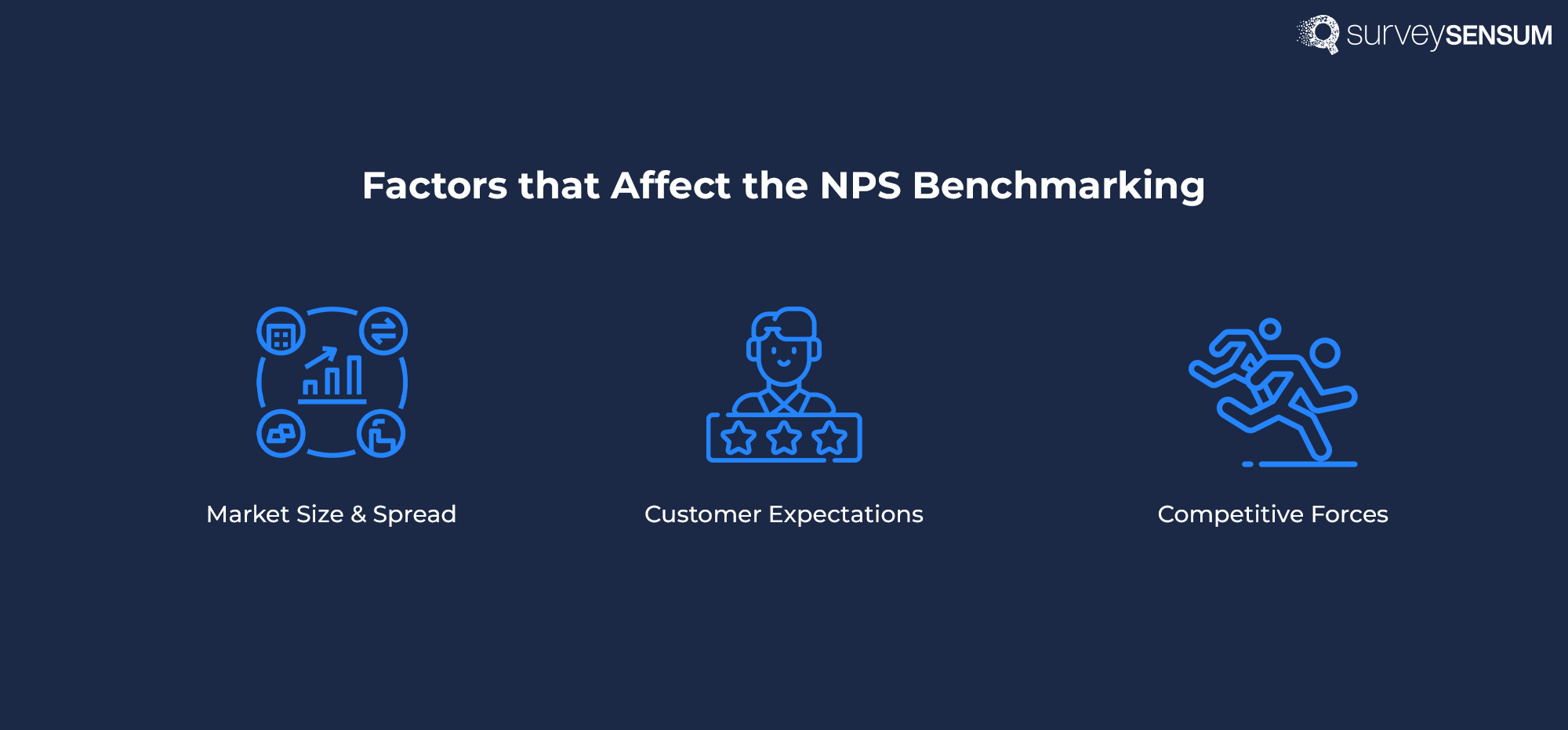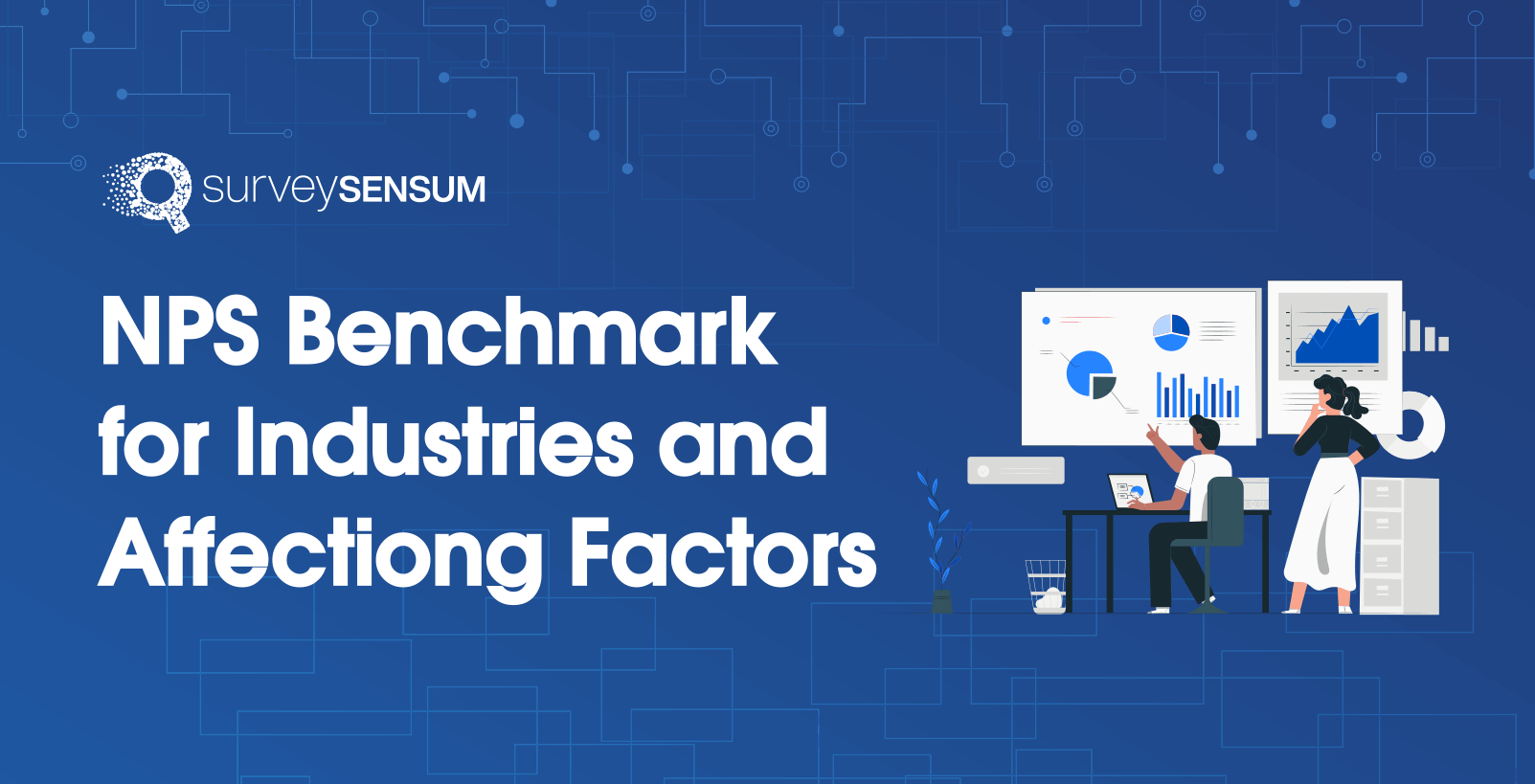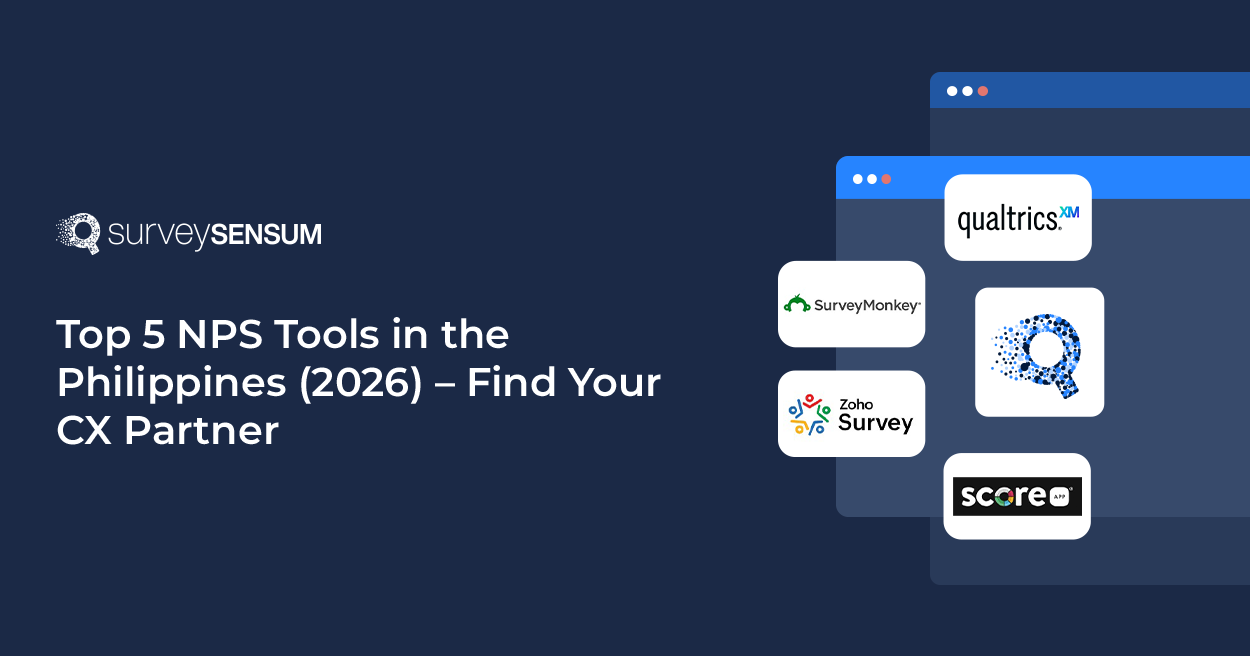

Is my NPS score good enough?
This is something that companies wonder a lot about the NPS score.
Calculating NPS is one thing but benchmarking the score against industry standards adds context and more meaning to the score.
Benchmarking is the process of comparing our company’s NPS score with scores of other companies in the same industry or sector. This can provide you with invaluable insights into your company’s performance and its position in the market. Moreover, benchmarking also provides actionable insights into industry trends and customer expectations, enabling you to stay ahead of the competition.
So, if you also wondered – Is my NPS score good enough or what is a good NPS score, then this blog is for you. In this blog, we’ll be talking about what are the factors affecting the NPS benchmark, the best practices to follow, the pros and cons of the NPS benchmark, along with NPS benchmarks by industry.
Let’s begin with understanding what NPS benchmarking is.
What is NPS Benchmarking?
NPS benchmarking is a process of comparing your organization’s NPS score against your competitors or industry peers to assess its relative performance in terms of customer loyalty and advocacy.
NPS benchmarking involves measuring and tracking the NPS over time and comparing it to industry averages, or specific competitors to gain insights into the organization’s position within the market.
Now the question is, how can you know where your brand stands and how good is your NPS score?
Let’s explore the Net Promoter Score benchmarks by industry with the recent Retently study.
NPS Benchmarks by Industry 2024
A study on NPS benchmarks by industry, revealed the average NPS score by different industries. The study was conducted for different industries, analyzing NPS in B2B and B2C. Based on the study, here are the NPS scores by industry.


*Source: Retently 2024 NPS Benchmarks for B2B & B2C
Now, with all this data in mind, you must be wondering – what is a good net promoter score? Well, let’s find out.
What is a Good Net Promoter Score?

As a thumb rule, a good Net Promoter Score is divided into three categories:
- NPS of 70 or Higher: This is often considered excellent and suggests that a company has a strong base of loyal customers who are highly likely to recommend its offerings to others.
- NPS of 30 and Up: This range is still regarded as good, indicating that the company has a solid foundation of satisfied customers who are generally willing to recommend it.
- NPS between 0 and 29: While positive, this range suggests room for improvement. It signifies that the company has more satisfied customers than dissatisfied ones but may not have fully tapped into its potential for customer advocacy.
Just make sure you don’t have a negative NPS score, i.e., below 0. This indicates that there are more Detractors than Promoters, signifying potential issues with customer satisfaction and loyalty. Negative scores require immediate attention and efforts to address underlying issues affecting customer experience.
Now, any positive integer can deemed to be a good NPS score since it indicates the overall positive sentiments of customers towards the business, a high number of promoters also suggests the possibility of creating brand advocates. However, the average NPS varies significantly from industry to industry. What constitutes a good NPS score for the hospitality industry may not apply to the retail industry.
This takes us to the two variants of the NPS:
Absolute and Relative NPS
ABSOLUTE NPS refers to the overall positive score where your score is marked as average against the score of all other industries. In RELATIVE NPS, the comparison is made with other companies in the same industry. For example, McDonald’s compares its NPS score with Burger King. This gives more context since it helps the business identify with certainty whether the score is good or bad. Also, relative NPS gives more clarity on the company’s position.
++ You need powerful NPS software capable of assessing both 11-point and 5-point NPS scales. This tool will assist you in crafting NPS surveys and deploying them strategically at the appropriate touchpoints and timings.
Feeling intimidated by the whole process of improving NPS? Fret not! With SurveySensum’s NPS experts, you will receive end-to-end support to make your NPS program a success.
But why are we doing all of this? Is benchmarking NPS worth it? Let’s find out.
Why Should You Benchmark Your NPS Score?
We all know that a high NPS score is definitely good because it means that the number of customers who love your brand is more than those who don’t.
- But how do you know what is a good NPS score (when the score is not high)?
- And what should be your goal or target for improvement?
That is where NPS benchmarking comes in, it doesn’t just tell you about your brand’s NPS score but gives you the entire picture.
Now, here are several more reasons for NPS benchmarking.
- Performance Evaluation: Benchmarking allows you to assess your net promoter score average by industry or competitors’ scores. This evaluation provides insights into how well your organization is performing in terms of customer loyalty and advocacy compared to others in your sector.
- Identifying Strengths and Weaknesses: Benchmarking enables you to identify where your business or product excels and the areas of improvement. Understanding these strengths and weaknesses allows you to focus your efforts on improving customer experience where it matters the most.
- Setting Realistic Goals: NPS benchmarking provides a baseline against which you can set realistic NPS improvement goals. By knowing where you stand relative to industry standards or competitors, you can establish achievable targets for enhancing customer satisfaction and loyalty.
- Strategic Decision-Making: Armed with benchmarking data, you can make informed strategic decisions to improve your organization’s customer experience. Whether it’s investing in new initiatives, refining existing processes, or allocating resources more effectively, benchmarking helps prioritize actions.
- Staying Competitive: Benchmarking allows you to stay competitive in the market by keeping tabs on how your NPS score compares to industry leaders or direct competitors. This understanding allows you to identify areas where you need to catch up or differentiate yourself to maintain or gain a competitive edge.
- Continuous Improvement: Benchmarking helps you foster a culture of continuous improvement within your organization. With regular monitoring, you can track progress over time. Iterate on strategies, improve customer retention, and implement changes that lead to sustained improvements in customer loyalty and advocacy.
So, calculate and improve your NPS score with SurveySensum’s NPS experts and boost your business’s growth.
How to Benchmark Your NPS Score?

1. Benchmark it Against the Industry Average
As discussed, the NPS score can vary with the industry. And that’s why an airline should not compare its NPS score with an internet company. For instance, the highest NPS score for an airline is 71, on the other hand, the highest NPS score for an internet service is 27. While they both are the best in their industry, they should now be compared.
However, if in the banking industry, your NPS score is 65 and the average score for NPS in banking is 70, then you need to improve a bit! And if your score is 72 then you are doing great!!
As said, there are multiple factors that affect your score. That’s why it’s crucial to benchmark your NPS against YOUR INDUSTRY average.
2. Benchmark it as Per Your Regional/Cultural Average
Here’s an insight: US consumers are more inclined toward premium-price products while Asians prefer budget-friendly products.
The same can be seen in their NPS responses.
So, without regional consideration, you will benchmark your NPS score incorrectly.
3. Benchmark Score Against the Channel’s Average
You must be asking for feedback on multiple channels eg, email, chatbot, and support calls. While NPS email surveys get more responses, in-app surveys or SMS surveys get very few.
That’s why you need to know how to calculate the NPS score according to the channels you are surveying!
Questions to Ask Yourself Before Benchmarking Your NPS Score
Q1. What should be the objective of your NPS Benchmarking?
- Goal Setting
- Competitive Comparison
- SWOT Analysis
Q2. What is your brand promise? Or the vision of the next 5 years.
This will help you decide what factors/journeys or products you want to benchmark yourself.
For example, you are a broadband company and aim to provide the fastest internet speed. Then that’s your brand promise and you should ask questions about that.
Q3. Against whom I should benchmark?
- Ideally, top 3-4 competitors covering 70% – 80% market and competitive alternatives.
- If you are a niche player then head to head with top competition.
Q4. How frequently should I do benchmarking?
- If an industry is quite dynamic like E-commerce it can be done Quarterly.
- For less dynamic industries (telecom, insurance, banking) semesterly or yearly benchmarking is good as you are also doing transactional CSAT.
Q5. How much sample is enough?
- Sampling design is done per brand and per area level.
- A minimum sample of 100 – 150 per brand per area is recommended.
Q6. Who should you reach in benchmarking?
- Own customers
- Key competition users
- Your lapsers (the people who left you for your competition
Q7. What actions should you take post-NPS benchmarking?
- Set goals against the competition
- Understand your relative weaknesses and improve
- Work on communication strategy
Q8. Which cities should you choose?
Pareto Principle: Top 4-5 regions covering 80% of sales
Q9. What research data do you already have?
There are always a few problems that customers complain about on a regular basis. Identify those problems and understand if you are losing your customers because of them. And if the same thing is happening with your competitors.
Factors that Affect the NPS Benchmarking

1. Market Size & Spread
The bigger the market size and geographical spread, the more varying would be the NPS score. A bigger market caters to customers hailing from diverse cultural backgrounds. Diverse customers with different mindsets often give different feedback.
For example, Europe-based customers are reserved when it comes to giving negative feedback, however, on the other hand, US-based customers are more generous while sharing their feedback. Similarly, there are countries like Japan where people usually give low ratings because it is considered rude to rate a business as either too good or too bad.
2. Customer Expectations
Customer expectations vary drastically with the industries.
For example, customers in the medical industry prioritize expertise and availability. Alternatively, customers in the internet service industry focus more on exceptional customer service. As a result of this, NPS scores that these industries achieve would be significantly different.
3. Competitive Forces
The level of competition involved in an industry also affects the NPS score drastically. A cut-throat competitive scenario would require businesses to innovate faster and better which would result in better customer service.
This should help lift the NPS score as well. On the other hand, a moderately competitive environment could slow down innovation or sustain the current level of customer service, which may not give a positive thrust to the NPS score.
Launch your first NPS survey with SurveySensum in just under 10 minutes and gather relevant and actionable insights.
What if You Cannot do NPS Benchmarking?
Even if you are unable to do benchmarking, no matter what size your business is, here’s what you can do.
- Start measuring different types of NPS for the first six months and see the trend.
- Take action on customer complaints and check the average score from time to time.
- Once the action is taken, SET UP a milestone, 5-10% higher than the current score, for the coming six or twelve months.
- Keep working on the customer feedback and don’t forget to INFORM your customers of the ACTIONS you’ve taken on their feedback.
- At last, MEASURE the impact of the actions you have taken and I promise your customers will be much happier and you’ll see an increase in your NPS score.
The trick is to LISTEN to your customers and ACT on their feedback.
Pros and Cons of NPS Benchmarking
| Pros | Cons |
| Gives a comparative picture of you vs competition | Expensive |
| Helps you to decide on a benchmark of NPS for goal setting and evaluation | Needs outside support as you need the database of competitor users to reach out |
| Helps in understanding your strengths vs competition | Time-taking |
| Helps in communication strategy | Not a tool for real-time action |
Launch your own NPS program with SurveySensuma to identify your detractors and convert them into your promoters!
Now that we know everything there is to know about NPS benchmarking, let’s talk about how SurveySensum can help.
Going Beyond the NPS Benchmarks: How can SurveySensum Help?
If you want to gather real-time insights on your customer loyalty, SurveySensum is the perfect NPS tool for you. The insights given by this platform can help you to maximize the ROI by steering the business operations.
It helps you create NPS surveys, gather customer feedback in one place, and help you take action on the shared feedback; enabling you to improve the experience across the entire customer journey.
For example, you run a retail store that can use SurveySensum to collect NPS data, allowing you to understand your customers’ satisfaction and make improvements accordingly, thus enhancing your NPS benchmarking in retail. The insights given by the SurveySensum platform can help you maximize the ROI by steering the business operations.
Here are some of the exclusive features of the SurveySensum survey software that help you enhance your customer experience.
1. Multi-Channel Surveys
With SurveySensum, you can send NPS surveys to multiple channels such as WhatsApp, email, chatbots, Slack, SMS, in-app, web app, and more. Also, you can incentivize your customers by integrating coupons or promo codes with the surveys.
2. CRM Integration
You know the best way to use your collected NPS data is to integrate it with your CRM. It gives you instant information about the customer and their emotions towards the brand. Also, you can automate sending surveys post certain actions or triggers.
3. Consolidated NPS view
SurveySensum comes with a customized dashboard view that gives you a quick glance at all the live analytical data. From the current NPS score, the NPS response rate of the ongoing survey, the percentage of detractors and promoters, top customer complaints, and more, everything is available on one screen! If required, you can also customize the dashboard further to create your own custom view with relevant data required for reporting.
4. Advanced Filters and Reports
Advanced filters and reports are other critical features of SurveySensum. All you need to do is select the filter as per your requirements and download the NPS reports. It’s that simple!
5. AI-Enabled Text Analytics
Analyzing qualitative feedback can be cumbersome! But the text analytics feature makes it easy for you. It tags all the customer feedback and segregates them based on the top customer complaints and sentiments. This enables you to prioritize customer issues and resolve them accordingly.
SurveySensum can help you raise your NPS score beyond the industry benchmarks. You can try it for free.
→ Improving your NPS also requires an insight into the impact of NPS on your revenue. When you understand the business KPIs involved in boosting your NPS and what impact they can bring to your revenue and ROI, then only you can see a clear path for improving NPS. This is where CX consultation from SurveySensum’s top CX experts will come in handy. These experts will provide end-to-end support – from creating effective surveys to analyzing them to creating a well-formed action plan by extracting insights from feedback.
Conclusion
NPS benchmarks offer invaluable insights into your company’s performance and customer loyalty landscape. By understanding where you stand relative to industry standards and competitors, you gain a clearer picture of your strengths and areas for improvement.
Now, after gaining this insight you need an action plan to improve your NPS, and your weak areas and boost customer satisfaction. To do that you need a robust NPS Software tools, like SurveySensum, that will help you with in-depth NPS analysis and help you extract actionable insights. Because in the end, it’s not just about meeting expectations – it’s about exceeding them, one promoter at a time.

















